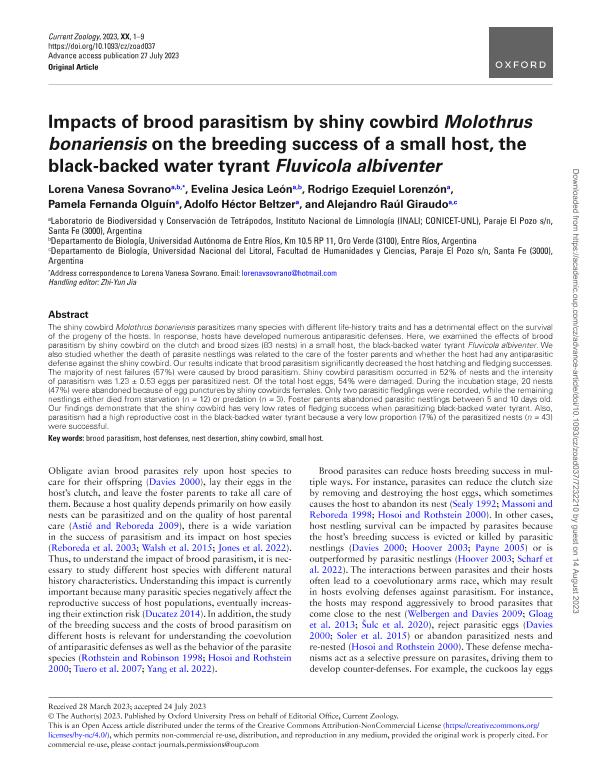Mostrar el registro sencillo del ítem
dc.contributor.author
Sovrano, Lorena Vanesa

dc.contributor.author
Leon, Evelina Jesica

dc.contributor.author
Lorenzón, Rodrigo Ezequiel

dc.contributor.author
Olguin, Pamela Fernanda

dc.contributor.author
Beltzer, Adolfo Hector

dc.contributor.author
Giraudo, Alejandro Raul

dc.date.available
2024-01-29T15:34:15Z
dc.date.issued
2023-07
dc.identifier.citation
Sovrano, Lorena Vanesa; Leon, Evelina Jesica; Lorenzón, Rodrigo Ezequiel; Olguin, Pamela Fernanda; Beltzer, Adolfo Hector; et al.; Impacts of brood parasitism by shiny cowbird Molothrus bonariensis on the breeding success of a small host, the black-backed water tyrant Fluvicola albiventer; Oxford University Press; Current Zoology; 7-2023; 1-9
dc.identifier.issn
1674-5507
dc.identifier.uri
http://hdl.handle.net/11336/225112
dc.description.abstract
The shiny cowbird Molothrus bonariensis parasitizes many species with different life-history traits and has a detrimental effect on the survival of the progeny of the hosts. In response, hosts have developed numerous antiparasitic defenses. Here, we examined the effects of brood parasitism by shiny cowbird on the clutch and brood sizes (83 nests) in a small host, the black-backed water tyrant Fluvicola albiventer. We also studied whether the death of parasite nestlings was related to the care of the foster parents and whether the host had any antiparasitic defense against the shiny cowbird. Our results indicate that brood parasitism significantly decreased the host hatching and fledging successes. The majority of nest failures (57%) were caused by brood parasitism. Shiny cowbird parasitism occurred in 52% of nests and the intensity of parasitism was 1.23 ± 0.53 eggs per parasitized nest. Of the total host eggs, 54% were damaged. During the incubation stage, 20 nests (47%) were abandoned because of egg punctures by shiny cowbirds females. Only two parasitic fledglings were recorded, while the remaining nestlings either died from starvation (n = 12) or predation (n = 3). Foster parents abandoned parasitic nestlings between 5 and 10 days old. Our findings demonstrate that the shiny cowbird has very low rates of fledging success when parasitizing black-backed water tyrant. Also, parasitism had a high reproductive cost in the black-backed water tyrant because a very low proportion (7%) of the parasitized nests (n = 43) were successful.
dc.format
application/pdf
dc.language.iso
eng
dc.publisher
Oxford University Press

dc.rights
info:eu-repo/semantics/openAccess
dc.rights.uri
https://creativecommons.org/licenses/by-nc-sa/2.5/ar/
dc.subject
BROOD PARASITISM
dc.subject
HOST DEFENSES
dc.subject
NEST DESERTION
dc.subject
SHINY COWBIRD
dc.subject
SMALL HOST
dc.subject.classification
Zoología, Ornitología, Entomología, Etología

dc.subject.classification
Ciencias Biológicas

dc.subject.classification
CIENCIAS NATURALES Y EXACTAS

dc.title
Impacts of brood parasitism by shiny cowbird Molothrus bonariensis on the breeding success of a small host, the black-backed water tyrant Fluvicola albiventer
dc.type
info:eu-repo/semantics/article
dc.type
info:ar-repo/semantics/artículo
dc.type
info:eu-repo/semantics/publishedVersion
dc.date.updated
2024-01-26T11:06:18Z
dc.identifier.eissn
2396-9814
dc.journal.pagination
1-9
dc.journal.pais
Reino Unido

dc.description.fil
Fil: Sovrano, Lorena Vanesa. Universidad Autónoma de Entre Ríos. Facultad de Ciencia y Tecnología; Argentina. Consejo Nacional de Investigaciones Científicas y Técnicas. Centro Científico Tecnológico Conicet - Santa Fe. Instituto Nacional de Limnología. Universidad Nacional del Litoral. Instituto Nacional de Limnología; Argentina
dc.description.fil
Fil: Leon, Evelina Jesica. Consejo Nacional de Investigaciones Científicas y Técnicas. Centro Científico Tecnológico Conicet - Santa Fe. Instituto Nacional de Limnología. Universidad Nacional del Litoral. Instituto Nacional de Limnología; Argentina
dc.description.fil
Fil: Lorenzón, Rodrigo Ezequiel. Consejo Nacional de Investigaciones Científicas y Técnicas. Centro Científico Tecnológico Conicet - Santa Fe. Instituto Nacional de Limnología. Universidad Nacional del Litoral. Instituto Nacional de Limnología; Argentina. Universidad Autónoma de Entre Ríos. Facultad de Ciencia y Tecnología; Argentina
dc.description.fil
Fil: Olguin, Pamela Fernanda. Consejo Nacional de Investigaciones Científicas y Técnicas. Centro Científico Tecnológico Conicet - Santa Fe. Instituto Nacional de Limnología. Universidad Nacional del Litoral. Instituto Nacional de Limnología; Argentina
dc.description.fil
Fil: Beltzer, Adolfo Hector. Consejo Nacional de Investigaciones Científicas y Técnicas. Centro Científico Tecnológico Conicet - Santa Fe. Instituto Nacional de Limnología. Universidad Nacional del Litoral. Instituto Nacional de Limnología; Argentina
dc.description.fil
Fil: Giraudo, Alejandro Raul. Consejo Nacional de Investigaciones Científicas y Técnicas. Centro Científico Tecnológico Conicet - Santa Fe. Instituto Nacional de Limnología. Universidad Nacional del Litoral. Instituto Nacional de Limnología; Argentina
dc.journal.title
Current Zoology
dc.relation.alternativeid
info:eu-repo/semantics/altIdentifier/url/https://academic.oup.com/cz/advance-article/doi/10.1093/cz/zoad037/7232210
dc.relation.alternativeid
info:eu-repo/semantics/altIdentifier/doi/http://dx.doi.org/10.1093/cz/zoad037
Archivos asociados
